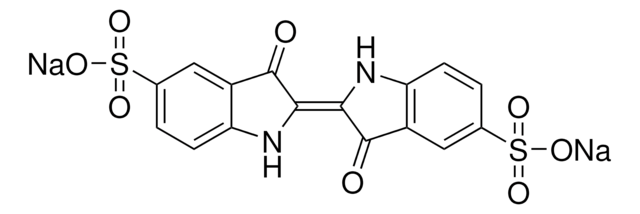81240
Poli(etilenglicole)
average Mn 4,000, platelets
Sinonimo/i:
PEG
Autenticatiper visualizzare i prezzi riservati alla tua organizzazione & contrattuali
About This Item
Formula condensata:
H(OCH2CH2)nOH
Numero CAS:
Numero MDL:
ID PubChem:
NACRES:
NA.23
Prodotti consigliati
Origine biologica
platelets
Stato
powder
PM
Mn 3,500-4,500
average Mn 4,000
Punto di fusione
58-61 °C
Estremità Ω
hydroxyl
Estremità α
hydroxyl
Stringa SMILE
C(CO)O
InChI
1S/C2H6O2/c3-1-2-4/h3-4H,1-2H2
LYCAIKOWRPUZTN-UHFFFAOYSA-N
Cerchi prodotti simili? Visita Guida al confronto tra prodotti
Descrizione generale
Polyethylene glycol (PEG) is a hydrophilic polymer. It can be easily synthesized by the anionic ring opening polymerization of ethylene oxide, into a range molecular weights and variety of end groups. When crosslinked into networks PEG can have high water content, forming “hydrogels PEG is a suitable material for biological applications because it does not trigger an immune response.
Applicazioni
Polyethylene glycol (PEG) platelets were used:
- in PEG-directed gene delivery of protoplast transfection and incubation
- to prepare extraction for measuring cytosolic phosphoenolpyruvate carboxykinase (PEPCK) from plant tissues
- as DNA transformation agent in a study of transient gene expression of plant protoplasts, derived from rice leaf sheaths.
- in preparing isothermal assembly buffer and TSS broth preparation for unique nucleotide sequence (UNS)-guided assembly of repetitive DNA parts
- in transformation of DNA into log-phase cells of the budding yeast Saccharomyces cerevisiae.
- as DNA transformation reagent
Altre note
Polymer networks with grafted cell adhesion peptides for highly biospecific cell adhesive substrates
Codice della classe di stoccaggio
11 - Combustible Solids
Classe di pericolosità dell'acqua (WGK)
WGK 1
Punto d’infiammabilità (°F)
Not applicable
Punto d’infiammabilità (°C)
Not applicable
Dispositivi di protezione individuale
Eyeshields, Gloves, type N95 (US)
Scegli una delle versioni più recenti:
Possiedi già questo prodotto?
I documenti relativi ai prodotti acquistati recentemente sono disponibili nell’Archivio dei documenti.
I clienti hanno visto anche
Oleg Raitskin et al.
PloS one, 14(2), e0211598-e0211598 (2019-02-28)
Molecular tools adapted from bacterial CRISPR (Clustered Regulatory Interspaced Short Palindromic Repeats) systems for adaptive immunity have become widely used for plant genome engineering, both to investigate gene functions and to engineer desirable traits. A number of different Cas (CRISPR-associated)
Shen, Jinbo, et al. "Isolation, culture, and transient transformation of plant protoplasts
Shen J, et al.
Current Protocols in Cell Biology, 2014, 2-8 null
A simple and effective method to encapsulate tobacco mesophyll protoplasts to maintain cell viability
Lei R, et al.
Methods, 24-32 (2015)
Jennifer DeMars Tripp et al.
Yeast (Chichester, England), 30(5), 191-200 (2013-03-14)
Chemical-based methods have been developed for transformation of DNA into log-phase cells of the budding yeast Saccharomyces cerevisiae with high efficiency. Transformation of early stationary-phase cells, e.g. cells grown in overnight liquid cultures or as colonies on plates, is less
Frédéric Sanchez et al.
Genes, 10(5) (2019-05-28)
Ostreococcustauri is an easily cultured representative of unicellular algae (class Mamiellophyceae) that abound in oceans worldwide. Eight complete 13-22 Mb genomes of phylogenetically divergent species within this class are available, and their DNA sequences are nearly always present in metagenomic
Il team dei nostri ricercatori vanta grande esperienza in tutte le aree della ricerca quali Life Science, scienza dei materiali, sintesi chimica, cromatografia, discipline analitiche, ecc..
Contatta l'Assistenza Tecnica.


